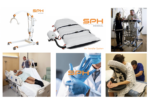Nurse managers don’t typically think of injury prevention during epidurals being a major issue. But epidurals are about pain relief so why are nurses at risk of injury? This article will review the Epidural placement procedure, proper patient positioning for optimal patient outcomes and Safe Patient Handling solutions to reduce the risk of injury for the nurses that support this procedure.
What is an Epidural?
This procedure involves injecting a patient with epidural analgesia blocking the spinal nerve impulses around the lower back. Unlike anesthesia which leads to a total lack of feeling, an epidural provides analgesia or pain relief. For example, when used for mothers before or during childbirth, the purpose is to numb the pain in the lower body during the birthing process. Though the pain significantly reduced, the mother remains conscious and can still use her muscles to push out the baby when the time comes. The use of epidural injections greatly reduces pain during labor; however, an epidural does not eliminate all the pain during delivery, but the contractions will come with less intensity. And with an epidural comes the risk on injury to the staff and or nurse, injury prevention during epidurals is extremely important to the nursing staff.
What Is an Epidural Positioning Device?
The newest innovation to support the epidural procedure is the Epidural Positioning Device (EPD), sometimes known as the Epidural Positioning Chair. It is an assistive device used to position the patient properly that allows optimal access for the Epidural placement. It has a 180-degree adjustable face rest, six-position adjustable armrest, flexible range from floor, and adjustable torso support. The patient is held by the epidural device firmly yet correctly positioned.
How does the EPD help Patients?
Before doctors started using the Epidural Positioning Device, a nurse would stack pillows below the patient and hold her position as the anesthetist injected the lower back. There was a significant risk of injury for both the patient and the health personnel. The risk was mainly due to the patient, who would be hard to restrain while in extreme pain. The epidural chair allows the correct positioning of the patient by encouraging cervical, thoracic and lumbar flexion while still maintaining a solid and stable position, ensuring the patient is safe and secure.
How does the EPD help Nurses?
An epidural device is also used in other medical procedures where the epidural injection is required. The use of epidural chairs has improved efficiency in epidural medical procedures by supporting patients so that nurses don’t have to manually hold, support, push, pull or apply counter pressure during the procedure. The epidural chair eliminates the risk of injuries such as back pains and body strains that nurses are likely to endure when supporting patients. The EPDs serve to position the patient correctly and more efficiently while also increasing injury prevention during epidurals for the nursing staff. Absolving nurses from the pressure and physical load experienced when holding patients in position.
Epidural Analgesia
Epidural analgesia is a procedure used to relieve pain and is commonly used during the birthing process to those who don’t want to undergo pain during labor. Some of the advantages of the epidural pain relief procedure include:
- Pain relief
- Give the mother enough time to rest after the nine months of pregnancy
- Help the mother to follow the birthing without much stress
- It may help reduce postpartum depression
- Epidural can be used at any stage of the labor
- It is effective during lengthy surgical procedures
Some of the downsides experienced during and after the epidural pain relief procedure include the following:
- Reduced coordination of movement as the legs may be a bit weak
- Persistent positional headache, which may require treatment for rapid resolution
- Lower back discomfort where the needle was placed
- Severe lowering of blood pressure once the epidural process gets underway
Such risks will require the medical personnel, especially the anesthesiologist, to remain alert, checking the vital signs as the procedure continues. The procedure could also lead to neurological injury, though this is rare among the healthy obstetrical population.
Giving birth should be a beautiful experience, but some women may get anxious due to the anticipated pain. That is why every woman has the freedom to decide the type of birthing process she would like to go through, whether it’s normal delivery or epidural. Ultimately the choice will be with her, and it is expected she will make the best choice assisted by the medical personnel.



